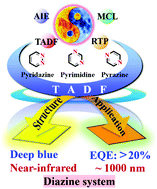Multipath exciton harvesting in diazine-based luminescent materials and their applications for organic light-emitting diodes
Abstract
Thermally activated delayed fluorescence (TADF) materials have attracted intensive interest in recent decades owing to their intrinsic merits of 100% exciton collection capability and relatively low-cost device fabrication. An abundance of TADF emitters with a donor–acceptor structure have been reported. Among them, the diazine-based TADF derivatives can not only form a wide range of emission spanning the entire region from deep blue to near-infrared through rational molecular design, but also realize multiple exciton utilization channels, such as aggregation-induced emission (AIE), room-temperature phosphorescence (RTP) and mechanochromic luminescence (MCL). Such diversiform variability in the same acceptor system is extremely infrequent and deserves in-depth understanding. Herein, a comprehensive review of diazine-based TADF materials is presented according to the relative position of two nitrogen atoms, including pyridazine, pyrimidine and pyrazine derivatives. Their molecular design, optoelectronic behavior, and related application in organic light-emitting diodes (OLEDs) have been systematically summarized, especially focusing on the subtle structure–property relationship. This review provides a guideline and further direction for the development of high-efficient and multifunctional luminescent materials.

- This article is part of the themed collection: Journal of Materials Chemistry C Recent Review Articles


 Please wait while we load your content...
Please wait while we load your content...